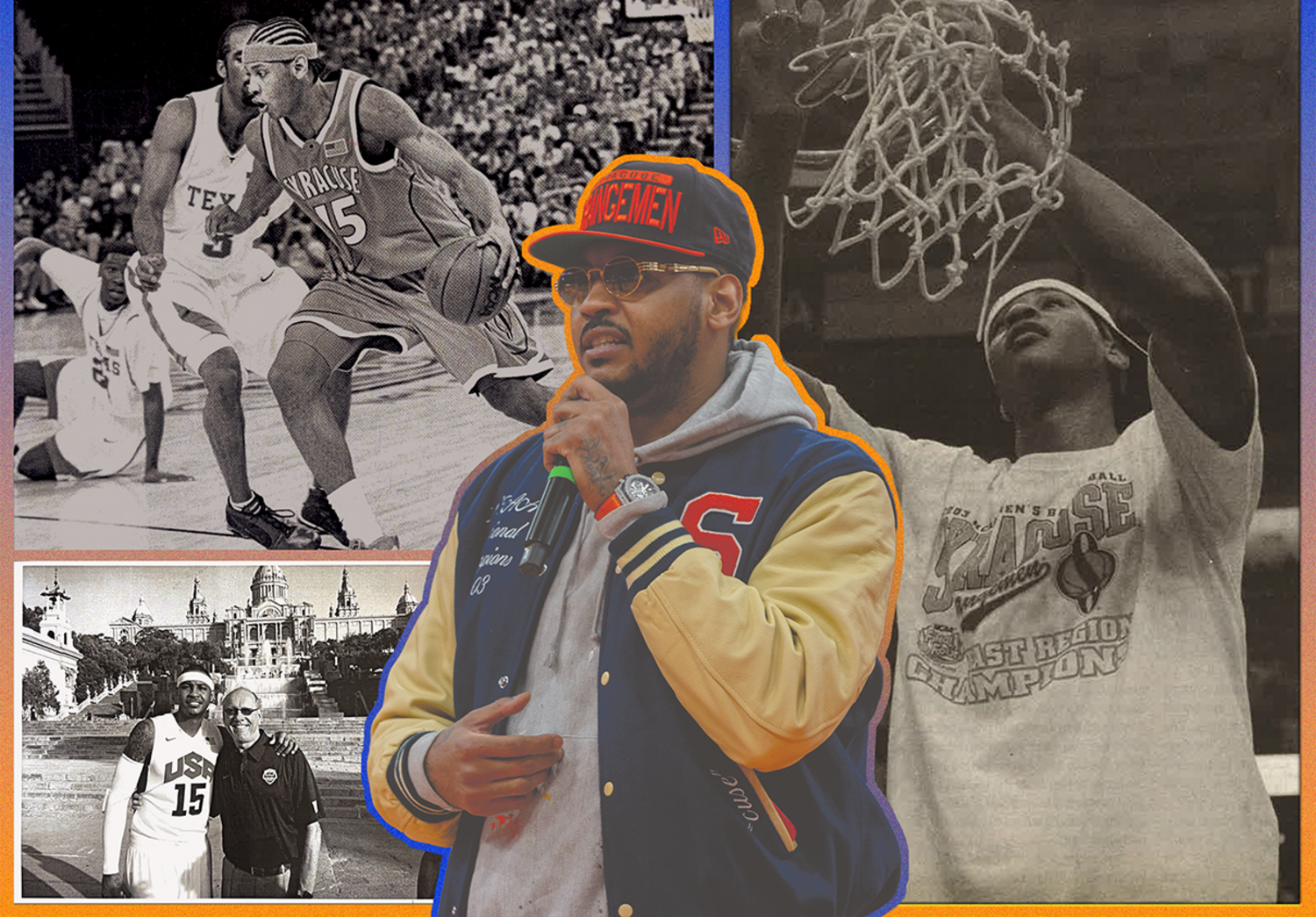A
s he glanced at a shirtless Carmelo Anthony, Hakim Warrick had doubts. Unlike current five-star recruits, who sometimes are bigger stars than NBA players before reaching college, Anthony’s teammates didn’t know much about him.
But based on Anthony’s status as a McDonald’s All-American and conversations with Syracuse assistant coach Troy Weaver, Warrick said he was expecting big things from his freshman teammate. That expectation briefly changed when Warrick eyed Anthony before their first practice.
“I was looking at him like, ‘Everyone’s so hype about this? This little chubby dude?’” Warrick said.
By the time the Orange finished practice that day at Archbold Gymnasium, any doubts were silenced — the 6-foot-8 forward possessed elite skill, strength and quickness. He wasn’t a normal freshman. Yet Warrick’s wildest dreams couldn’t have envisioned the transcendent campaign Anthony was about to have.
In his first step toward becoming a first-ballot Basketball Hall of Fame selection — where he’ll be inducted Saturday — Anthony led Syracuse to its lone national championship in 2003. Throughout the campaign, he starred as the first freshman in modern men’s college basketball history to lead the title-winning team in scoring (22.2 points per game).
Following one of the greatest college seasons ever, Anthony declared for the NBA Draft, becoming the second freshman ever to be a top-three selection. At SU, Anthony blazed his own path during an era when most top prospects either skipped college or stayed for several years, paving the way for a new generation of one-and-done stars.
“It was unheard of,” Warrick said of Anthony’s year with the Orange. “Coming in and being a freshman and putting up numbers is cool. But to put up numbers and win the way we did that, that’s just something that wasn’t done before.”

Carmelo Anthony beams with pride after capturing Syracuse’s lone national title in 2003. Anthony notched a 20-point, 10-rebound double-double in the championship game versus Kansas. Daily Orange Archive Photo
Before Anthony’s No. 15 became the most popular jersey in Syracuse, junior walk-on Andrew Kouwe remembers times he went to the mall with his soon-to-be superstar teammate unbothered. Meanwhile, some other top recruits — like Kobe Bryant, Kevin Garnett and LeBron James (the No. 1 pick in Anthony’s draft class) — jumped straight to the NBA from high school.
When SU head coach Jim Boeheim first watched Anthony as a high school junior at Towson Catholic (Maryland), he was rated around 40th in the country. Still, Weaver, then new to Boeheim’s staff, told his boss that Anthony could help SU win a national championship.
“I was obviously skeptical about that,” Boeheim said.
Like Warrick, Boeheim didn’t know much about Anthony until watching him play for the first time. A 3-pointer, mid-range jumper and dunk on three straight plays to begin the game was all he needed to see.
“You might be right about this guy,” Boeheim said to Weaver. “He might be that good.”
After committing to SU later in his junior year, Anthony transferred to powerhouse Oak Hill Academy (Virginia). There, he transformed his game and body, rising to No. 2 on the Recruiting Services Consensus Index (RSCI) for the 2002 class.
After dazzling during his first practice with the Orange, everyone within the program knew Anthony had a special talent. But to say he’d lead it to a national championship? Nobody thought that far.
After all, Syracuse had just missed its first March Madness in five years, and its two leading scorers were no longer with the program. Besides senior guard Kueth Duany and junior center Jeremy McNeil, the Orange desperately lacked the upperclassmen typically necessary for a title run; Maryland, which won the 2002 national championship, was anchored by seven upperclassmen.
Though SU lacked experience, it featured an influx of underclassmen talent. Alongside Warrick, a forward, Syracuse had guard Josh Pace and center Craig Forth returning for their sophomore years. And beyond Anthony, talented guards Gerry McNamara (No. 38 RCSI) and Billy Edelin (No. 36 RCSI) rounded out the Orange’s freshmen class.
Expectations remained modest for the Orange, as they were unranked in the Preseason AP Poll and selected to finish third in the Big East’s West Division in the conference’s Preseason Poll.
Despite Anthony immediately introducing himself with 27 points against Memphis at Madison Square Garden, SU dropped its first game of the year. McNamara admitted that, while Anthony was ready for the spotlight, it took time for everyone else to grow into it.
Following his stellar debut, Anthony led Syracuse to 11 straight wins, laying the foundation for Big East freshman records in scoring and double-doubles once conference play began. Recognition followed, with the Orange earning an AP Poll ranking on Jan. 13. Yet Anthony hit a lull as SU went 2-2 over its next four games, which included road losses to Pittsburgh and Rutgers.
Warrick remembers Boeheim laying into Anthony postgame after falling to the Scarlet Knights.
“That kind of rallied us, just seeing that Coach Boeheim would get into our best player like that,” Warrick said. “And from there on, we just snowballed and picked up some wins and kept going. We felt we could play with anybody.”

Sophia Burke | Digital Design Director
Syracuse responded by finishing the regular season with a 10-1 stretch.
As the Orange surged to the best record in the Big East and finished the season ranked No. 13 in the AP Poll, Anthony proved he was among the best players in the country. Before expanding his legend in postseason play, Anthony was named National Freshman of the Year, a second-team All-American, Big East Rookie of the Year and All-Big East First Team.
“He just took charge offensively right from the beginning, and nobody was able to contain him the whole year,” Boeheim said. “He’s just a great offensive player, and those guys are valuable commodities in the NBA.”
Despite bowing out in the Big East Tournament semifinal, Syracuse earned a No. 3 seed in the NCAA Tournament. Even with Anthony’s dominance, McNamara’s emergence (13.3 PPG) and Warrick’s sophomore leap (14.8 PPG), Warrick felt there wasn’t much expected from Syracuse in the tournament because its three best players were underclassmen.
Warrick thought it helped SU knowing it wasn’t the favorite. As McNamara recalled, the Orange were the youngest team in the NCAA Tournament, but that was never an excuse. They expected to win.
“You’re just naive in it,” McNamara said. “It’s your first time going through it, you’re confident, you think you can tackle the world.”
While Anthony averaged 15 points across the first weekend of the tournament, McNamara credits Edelin, Pace and McNeil — who all came off the bench — in ensuring Syracuse advanced to the Sweet 16. Once SU advanced, McNamara felt winning the title was attainable.
Auburn and No. 1 seed Oklahoma stood in the way. McNamara thought SU was better than both teams at that point. Led by Anthony’s team-high 18 against the Tigers and 20 against the Sooners, SU clinched its third Final Four appearance under Boeheim.
This booked a matchup with Texas, led by National Player of the Year T.J. Ford. When Anthony drew several foul calls versus the Longhorns, Kouwe remembers laughing on the bench when Ford complained to the refs that Anthony wasn’t Michael Jordan.
“(Anthony’s) game just frustrated, and almost kind of broke, the best player in college basketball at the time,” Kouwe said. “That’s what made him so special.”
Thirty-three points, 14 rebounds and a commanding 95-84 win later, it was clear Anthony was the actual best player in the country.
Two days later, Anthony — on a hurt back — poured in one of his most complete performances of the season against Kansas in the title game. In an 81-78 win, Anthony notched a game-high 20 points, 10 rebounds and seven assists en route to capturing the Orange’s elusive first title and sealing one of the best seasons the sport has ever seen.

After his dominant freshman season, Carmelo Anthony lifts the national championship trophy. Two months later, Anthony was selected with the third overall pick in the 2003 NBA Draft by the Denver Nuggets. Daily Orange Archive Photo
While naysayers doubted the Orange’s lack of experience, McNamara’s six first-half 3-pointers and Warrick’s game-sealing block were also key components for the Orange to make history.
Despite his desire to return to SU, Anthony couldn’t pass up the opportunity to play in the NBA. McNamara felt bad after hearing Anthony was leaving for the NBA because he knew how much his year and the people at Syracuse meant to him — something hard to imagine in today’s landscape.
Cooper Flagg, the No. 1 pick in the 2025 NBA Draft after one season at Duke, said in an interview with The Athletic mid-season that he wanted to return for a second year. But Flagg’s desire for another year with the Blue Devils meant nothing. He was always going to the NBA.
That’s because the path was already set in stone; including Flagg, eight of the last 10 first overall picks were one-and-done college players. That wasn’t the case in 2003.
“When Melo did what he did, I think not only did it change the way maybe the NBA was a little bit doing things, I think it probably motivated a generation right below us to be like, ‘I want to do that,’” McNamara said.
While the high school to NBA pipeline was vastly more popular than the one-and-done route during the 2004 and 2005 NBA Drafts, the NBA changed its minimum draft age from 18 to 19 in 2006. It opened the one-and-done floodgates.
Kevin Durant. Anthony Davis. Anthony Edwards. The list goes on.
While all have tantalizing skillsets, one-and-done prospects aren’t built the same — some are dynamic guards, others are polarizing big men and one may look a little chubby. But they all have one thing in common: they’re trying to dominate college basketball for one year before having Hall of Fame professional careers.
Just like Carmelo Anthony.
Collage by Ilana Zahavy | Presentation Director, photos courtesy of SCRC, Daily Orange Archive Photo, Meaghan Hendricks | Daily Orange File Photo
Published on September 3, 2025 at 11:06 pm



